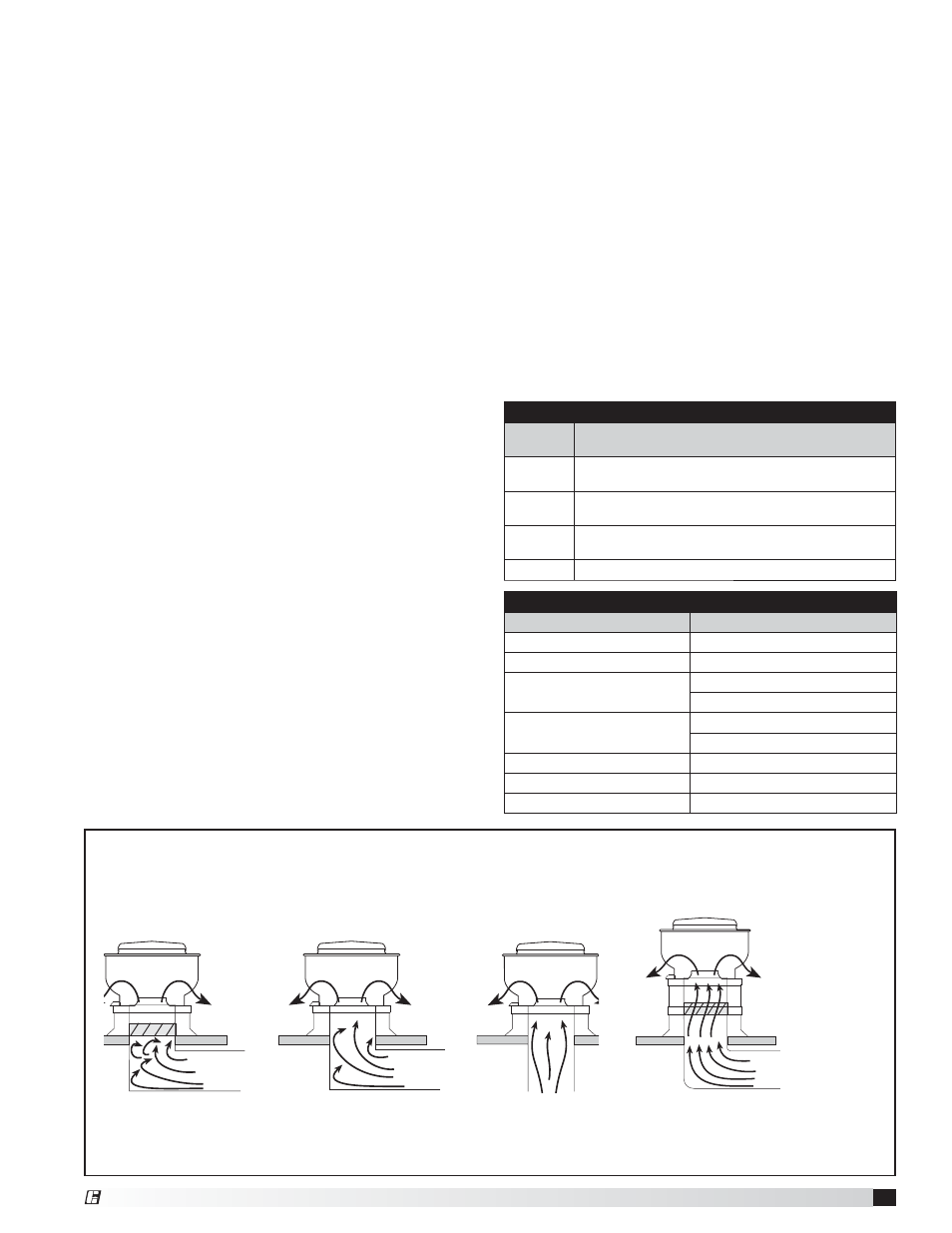Fan inlet connections, Recommended relubrication frequency in months, Belt/bearing maintenance cube unit – Greenheck CUE/CUBE (471560) User Manual
Page 9

9
Upblast Centrifugal Roof Exhaust Fans
Fan Inlet Connections
In order to assure proper fan performance, caution must be exercised in fan placement and connection to the ventilation
system. Obstructions, transitions, poorly designed elbows, improperly selected dampers, etc, can cause reduced
performance, excessive noise and increased mechanical stress. For performance to be as published, the system must
provide uniform and stable airflow into the fan.
Dampers must open fully.
Use motorized dampers in
low airflow applications to
reduce losses.
Avoid sharp turns or
entrance conditions which
cause uneven flow. Use
turning vanes in elbows to
reduce adverse effects.
Provide uniform airflow
at fan inlet to assure
optimum performance.
Provide uniform airflow at fan inlet and
through the damper to assure optimum
performance. The curb cap should be
three wheel diameters from the radius. Use
turning vanes in duct when possible.
Poor
Poor
Good
Good
Table 3: Grease Manufacturers
Manufacturer
Grease (NLGI #2)
U.S. Electric Motors
Grease No. 83343
Chevron U.S.A. Inc
Chevron SRI Grease #2
Mobil Oil Corporation
Mobilith
Mobil 532
Texaco, Inc.
Premium BRB #2
Texaco Multifak #2
Amoco Oil Co.
Rykon Premium #2
Exxon
Unirex N2
Shell
B Shell Alvania #2
Table 2: Suggested Fan Bearing Greasing Intervals
Interval
(months)
Type of Service
1 to 3
Heavy duty in dirty, dusty locations; high ambient
temperatures; moisture laden atmosphere; vibration.
3 to 6
12 to 24 hours per day, heavy duty, or if moisture
is present
6 to 12
8 to 16 hours per day in clean, relatively dry
atmosphere
12 to 18
Infrequent operation or light duty in clean atmosphere
Recommended Relubrication
Frequency in Months
NOTE: If unusual environment conditions exist (extreme
temperature, moisture or contaminants) more frequent
lubrication is required.
A good quality lithium base grease, conforming to
NLGI Grade 2 consistency, such as those listed here
may be used.
Belt/Bearing Maintenance CUBE Unit
1. Belts tend to stretch after a period of time. They
should be checked periodically for wear and
tightness. When replacing belts, use the same type
as supplied with the unit.
2. Matched belts should always be used on units with
multi-groove pulleys.
3. For belt replacement, loosen the tensioning device
enough to allow removal of the belt by hand.
4. Once installed, adjust belts as shown in
“Pre-Starting Checks.”
5. Shaft bearings can be classified in two
groups: relubricating and non-relubricating. All
non-relubricating bearings on standard Model
CUBE fans are factory lubricated and require no
further lubrication under normal use (between
-20º to 180ºF (-29º to 82ºC) in a relatively clean
environment).
6. On CUBE belt driven fans, the standard cast
pillow block bearings are factory lubricated and
are provided with external grease fittings. Annual
lubrication is recommended, or more frequently
if needed, see Table 2. Do not over-grease. Use
only one or two shots of lubricant with a hand
gun. Maximum hand gun rating is 40 psi. Rotate
bearings during lubrication where good safety
practice permits. Caution should be employed to
prevent over packing or contamination. Grease
fittings should be wiped clean. Extreme care should
be used around moving parts.
7. Grease should be pumped in very slowly until a
slight bead forms around the seal. A high grade
lithium base grease should be used.
8. When installing restaurant exhaust applications
follow NFPA 70 for cleaning fans.
9. Grease containers must be emptied at regular
intervals to prevent overflow.
10. To ensure tightness, check pulley setscrews.
Proper keys must be in keyways.
11. Fan RPM should not be readjusted.
Only use pulleys of identical size and type when
replacing pulleys.
12. During the first few months of operation check
bearing set screws periodically to ensure tightness.
13. If unit is to be left idle for an extended period,
remove belts and store in a cool, dry place to avoid
premature belt failure.
®
